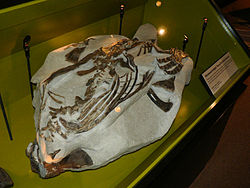- Montanoceratops
-
Montanoceratops
Temporal range: 70 MaMontanoceratops fossil at the Royal Tyrrell Museum Scientific classification Kingdom: Animalia Phylum: Chordata Class: Reptilia Superorder: Dinosauria Order: Ornithischia Suborder: Cerapoda Infraorder: Ceratopsia Family: Leptoceratopsidae Genus: Montanoceratops Binomial name Montanoceratops cerorhynchos
Sternberg, 1951Montanoceratops (meaning "Montana horned face") was a genus of small ceratopsian dinosaur. It lived during the early Maastrichtian of the late Cretaceous Period. Its fossils, as its name indicates, have been found in Montana.
Contents
Discoveries and species
The first fossil remains of what we now know as Montanoceratops were collected in Buffalo Lake, Montana in the St Mary River Formation by Barnum Brown around 1916, he and his assistant Erich M. Schlaikjer publishing it in 1935 as Leptoceratops cerorhynchos. However, later C.M. Sternberg found more material of Leptoceratops which showed the former was a distinct genus and hence Montanoceratops was coined.
The original material collected by Barnum Brown was meagre; more of the skull was absent than present, as well there were some vertebrae, pelvis and hindlimb material. Further material was found and published in a paper by Brends Chinnery and David Weishampel in 1998.
Classification
Montanoceratops belonged to the Leptoceratopsidae within the Ceratopsia (the name is Greek for "horned face"), a group of herbivorous dinosaurs with parrot-like beaks which thrived in North America and Asia during the Cretaceous Period, which ended roughly 65 million years ago. All ceratopsians became extinct at the end of this era.
Paleobiology
Montanoceratops was a typical primitive ceratopsian in many respects, distinguished from the later species by the presence of claws, rather than hooves, and by having teeth in its upper jaw, rather than a toothless beak. It was once thought to have a horn on its nose but that was a misplaced cheek horn.[1] Another unusual feature was the presence of tall spines on the bones of the tail. Although these would not have been visible during life, they would have made the tail unusually deep in cross-section. Since the tail was also highly flexible, it is possible that it was used in intra-species signalling, and that the deep shape made it more visible.[2] Montanoceratops was about 3 metres (9.8 ft) long from head to tail.[3][1] Montanoceratops, like all Ceratopsians, was a herbivore. It would have used its sharp Ceratopsian beak to bite off the leaves or needles.
References
- ^ a b Holtz, Thomas R. Jr. (2008) Dinosaurs: The Most Complete, Up-to-Date Encyclopedia for Dinosaur Lovers of All Ages Supplementary Information
- ^ Bakker, Robert (1986). The Dinosaur Heresies. Kensington Publishing Corp.. p. 98. ISBN 0-806-52260-7.
- ^ Palmer, D., ed (1999). The Marshall Illustrated Encyclopedia of Dinosaurs and Prehistoric Animals. London: Marshall Editions. p. 164. ISBN 1-84028-152-9.
- Chinnery, BJ & Weishampel, DB (1998). "Montanoceratops cerorhynchus (Dinosauria: Ceratopsia) and relationships among basal neoceratopsians". Journal of Vertebrate Paleontology 18 (3): 569–585. doi:10.1080/02724634.1998.10011085.
- http://www.vertpaleo.org/jvp/18-569-585.html (online abstract of preceding article)
External links
 Media related to Montanoceratops at Wikimedia Commons
Media related to Montanoceratops at Wikimedia Commons  Data related to Montanoceratops at WikispeciesCategories:
Data related to Montanoceratops at WikispeciesCategories:- Dinosaurs of North America
- Cretaceous dinosaurs
- Ceratopsians
Wikimedia Foundation. 2010.



